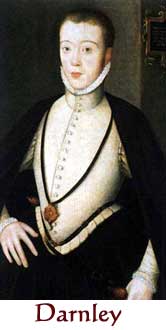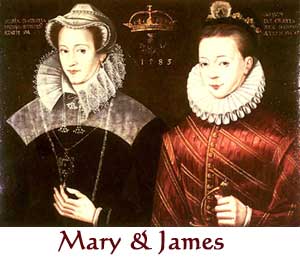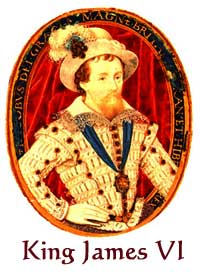Mary,
Queen of Scots, was born in 1542 and was executed on 1587.
It is generally believed that Mary's execution - ordered by
Elizabeth I - was the final reason Philip II needed to launch
the Spanish Armada. There are few other figures in Tudor England
who had such an eventful life, though for Mary, Queen of Scots,
it was to end in tragedy.
Mary was Elizabeth I's cousin. Mary had been brought up as
a strict Catholic which put her at odds with the Protestant
Elizabeth. Mary's father, James V of Scotland, died on December
14, 1542 . Mary became the ruler of Scotland from December
14, 1542, on September 9, 1543, she was formally crowned in
Stirling Castle. At such a young age, the Scottish lords found
it difficult to respect her and by 1548, Mary was sent to
France for her own safety.
As a young girl, Mary lived in France
where she had married the king of France - Francis II. She
was fifteen and he was fourteen. Her father-in-law, Henry
II, king of France, said of her
"the little Queen of Scots is
the most perfect child I have ever seen."
While in France, Mary lived in luxury
traveling from one palace to another. She developed a love
of animals - especially dogs - and spent a lot of time learning.
She could speak French, Latin, Spanish and some Ancient
Greek. Mary could also play the lute with some skill. Her
religious teacher was a monk from the priory at Inchmahome
in Scotland and she developed very strong views on religion.
Her doting father-in-law, Henry II,
had been killed in a jousting accident in 1559. Her mother
had died in Scotland in 1560. Her husband, Francis had always
been a sickly youth and his death aged sixteen in 1560 surprised
no-one but it left Mary a widower at the age of seventeen.
Within just six months she had lost three close members
of her family. Many say that she never really recovered
from this sad period in her life.
She returned to Scotland as Queen of
the Scots aged eighteen in 1561.
 In
1565, she married her cousin, Lord Darnley, when she was
22. He was very unpopular with the people of Scotland as
he was a violent, bad-tempered drunkard. During their marriage,
Mary's secretary was an Italian called David Rizzio. Darnley
got it into his head that they were spending too much time
together and in 1566, while Mary was entertaining some of
her friends in her private rooms, Rizzio, who was a guest
at Mary's supper party, was attacked by a gang including
Darnley and stabbed over 50 times. Mary was horrified. In
1565, she married her cousin, Lord Darnley, when she was
22. He was very unpopular with the people of Scotland as
he was a violent, bad-tempered drunkard. During their marriage,
Mary's secretary was an Italian called David Rizzio. Darnley
got it into his head that they were spending too much time
together and in 1566, while Mary was entertaining some of
her friends in her private rooms, Rizzio, who was a guest
at Mary's supper party, was attacked by a gang including
Darnley and stabbed over 50 times. Mary was horrified.
However, in June 1566, Mary gave birth
to a baby boy called James. He was to become the king of
England when Elizabeth died in 1603. Mary's marriage with
Darnley remained full of stress and she became more and
more attracted to the Earl of Bothwell.
On February 9th 1567, Mary and Darnley
was at a house called Kirk O'Field. Late in the evening
she remembered that she had to see some friends and rode
off. Scotland was a very dangerous country in the Sixteenth
Century and it would have needed a very brave person to
venture out at night without being fully guarded. That night,
Kirk O'Field was blown up. Darnley's body was found in the
garden of the house. The explosion had not killed him -
he had been strangled. Just three months later, Mary married
Bothwell. He was as disliked as Darnley by the Scots lords
and they rose up against Mary. Bothwell escaped to Europe
where he died an alcoholic and all but insane. Mary was
arrested and held prisoner at Lochleven Castle.
 She
was made to give up the throne for James, her son. Mary
later escaped from her prison and she fled to England where
she hoped her cousin, Elizabeth, would look after her. Mary's
logic was twofold. First, Mary was a queen and so was Elizabeth.
Mary expected a queen to help a queen. Secondly, Mary assumed
that their family ties would prove strong. She could not
have been more wrong. At the age of 25, the former queen
of Scotland started a lengthy spell in a number of manor
houses or castles that were her prison. She
was made to give up the throne for James, her son. Mary
later escaped from her prison and she fled to England where
she hoped her cousin, Elizabeth, would look after her. Mary's
logic was twofold. First, Mary was a queen and so was Elizabeth.
Mary expected a queen to help a queen. Secondly, Mary assumed
that their family ties would prove strong. She could not
have been more wrong. At the age of 25, the former queen
of Scotland started a lengthy spell in a number of manor
houses or castles that were her prison.
In 1586, a man called Anthony Babington
devised a plot to kill Elizabeth, rescue Mary and then see
her as the next queen of England. Babington wrote in code
to Mary to explain what he was doing. Mary wrote back, stating
that she agreed with what he was doing. Walsingham's spies
intercepted both letters. Babington was arrested and charged
with treason. In September 1586, Babington was executed.
Now the government had a case against Mary. She was put
on trial in October 1586.
Mary defended herself well but the
judges found her guilty of treason. To the judges, who would
not listen to her arguments, she said "You are indeed
my enemies". The reply was "We are the enemy of
the enemies of our queen." The trial lasted just 2
days.
Mary was found guilty of plotting
to kill Elizabeth. She was sentenced to death. In February
1587, Mary was given just 24 hours notice that she would
be executed the next day.

Regardless of this, Babington admitted
his part in the plot and he admitted that Mary knew about
the plot against Elizabeth all along. However, it is almost
certain that his confession was as a result of torture.
Elizabeth hesitated about signing Mary's
death warrant. Eventually she did and Mary was executed
at Fortheringhay Castle, 70 miles north of London, on February
8th, 1587. Mary was not allowed to have her chaplain present
at her execution.
Mary's execution was a curious affair.
She dressed in scarlet, the colour of martyrdom. She had
to be helped onto the scaffold as she was so frail. She
spoke her last words in Latin and then putting her head
onto the block said "Into your hands, O Lord"
three times, again in Latin. It took two goes with the axe
to remove her head. When the executioner lifted up her head,
he found that he had a wig in his hand and the actual head
was still on the scaffold. No-one had known that she had
lost her hair. Then her body moved. Underneath her skirt,
a small dog, a Skye terrier, was seen. Mary had brought
her dog to her own execution..........
 In
1612, her son and the now king of England, James, brought
his mother's body to Westminster Abbey where she was buried
in a magnificent tomb. In
1612, her son and the now king of England, James, brought
his mother's body to Westminster Abbey where she was buried
in a magnificent tomb.
Article Submitted By Neil Ritchie
|





